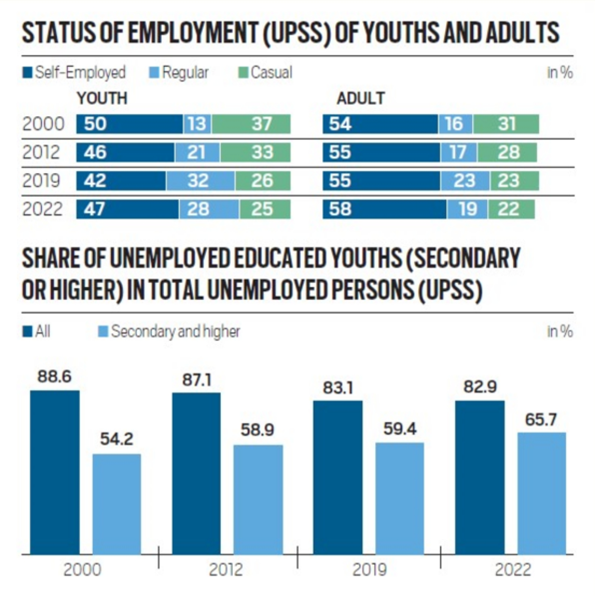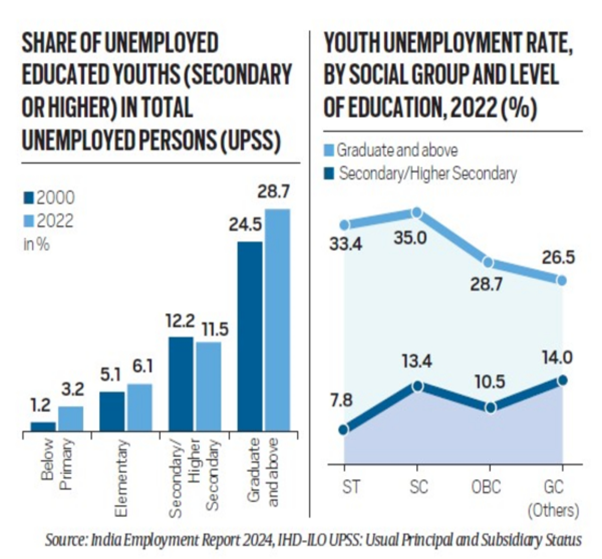JOBS, STILL
Relevance: GS 3 – Indian Economy and issues relating to planning, mobilization, of resources, growth, development and employment.
Why in the News?
- A report by the International Labour Organisation (ILO) revealed that over 80% of India’s unemployed workforce is comprised of youth.
- ‘The India Employment Report 2024,’ co-released by ILO and the Institute of Human Development (IHD), highlighted that the percentage of unemployed youth with secondary education or higher increased from 35.2% in 2000 to 65.7% in 2022.
- However, A report released by Chief Economic Adviser V. Anantha Nageswaran indicated that youth unemployment and underemployment rose between 2000 and 2019.
- The youth unemployment rate more than doubled from 7% in 2000 to 17.5% in 2019. However, during the pandemic years, the rate decreased to 12.4% in 2022.
Indian Economy’s Growth Momentum
- Recent data indicates a robust growth momentum in the Indian economy.
- In February, the National Statistical Office revised its GDP growth forecast for 2023-24 to 6%, up from the previous estimate of 7.3%.
- The Reserve Bank of India, in its February monetary policy committee meeting, projected a 7% growth for the economy in 2024-25.
Concerns Over the Labour Market
- Despite positive growth projections, concerns remain about the state of the labour market and the ability of the economy to generate more productive employment.
- Data from periodic labour force surveys shows a consistent increase in the labour force participation rate.
- The participation rate for individuals aged 15 and above rose from 49.8% in 2017-18 to 57.9% in 2022-23.
- A significant part of this rise is attributed to more women joining the labour force, with the female participation rate increasing from 23.3% to 37% during this period.
Details from the India Employment Report 2024
- Post-2019, approximately two-thirds of the employment growth consists of self-employed workers.
- Among the self-employed, a majority are unpaid family workers, mainly women.
- Employment in the agricultural sector has seen an increase, while the share of employment in manufacturing has remained largely unchanged.
- Employment Trends in India (2000-2022): Between 2000 and 2022, employment in India was predominantly in the form of self-employment and casual labor, as per the report.
- Nearly 90% of the workforce is involved in informal employment
- Shifts in Employment Types: The proportion of regular employment, which had been consistently increasing since 2000, started declining after 2018.
- Insecurities and Lack of Social Protection: The report emphasized widespread insecurities related to livelihoods. Only a small fraction of workers, particularly those in the non-agricultural organized sector, are covered by social protection measures.
- Central Issue of Job Creation in India
- Job creation is a central concern for India’s development.
- The challenge is to create more productive employment opportunities as current employment is mainly in the form of self-employment and casual wage labor.
- The report estimates that 7 to 8 million new individuals enter the labor market each year.
- Youth Unemployment and Challenges
- Youth unemployment decreased from 5% in 2019 to 12.1% in 2022.
- However, unemployment rates are higher among:
- Young people in urban areas.
- Individuals with higher levels of education.
- Demographic Dividend and Employment Needs:
- To leverage the demographic dividend, there’s a need to offer more productive employment to these specific groups.
- Changing Nature of Production and Skill Requirements:
- The production process has become increasingly capital-intensive and labor-saving.
- The skill intensity of employment in industry and services has risen, which is contrary to the current labor market needs of the country.
Stagnant Wages and Contractual Employment
- There has been a noticeable increase in contractual employment.
- Only a minority of regular workers have long-term contracts, leading to rising concerns about job security.
- Wage trends from 2012-22:
- Wages for casual laborers showed a modest upward trend.
- Real wages for regular workers remained stagnant or decreased.
- Self-employed real earnings declined after 2019.
Slight Improvement in Labour Participation
- The Labour Force Participation Rate (LFPR), Worker Population Ratio (WPR), and Unemployment Rate (UR) deteriorated from 2000 to 2018.
- There was a post-2019 improvement, with exceptions during economic distress and two peak Covid-19 quarters.
- The report urges caution in interpreting this improvement due to concerns about the underlying factors driving these changes.
Skills Deficiency Among the Youth
- Despite India’s significant youthful population, there is a notable deficiency in essential skills among the youth:
- 75% struggle with sending emails with attachments.
- 60% have difficulties with basic file operations like copy and paste.
- 90% face challenges with handling mathematical formulas in spreadsheets.
India’s Youth Population and Employment
- The report predicts a decline in India’s youth population from 27% in 2021 to 21% by 2036.
- Approximately 7-8 million youths are expected to be added to the workforce annually.
- Youth employment in India generally offers lower quality compared to adult employment, with a higher prevalence of vulnerable occupations or engagement in the informal sector among young workers.
Required Policy Responses: The policy response should be multifaceted, focusing on:
- Quality Education and Skill Development: Ensuring access to quality education. Promoting skill development to meet the demands of the evolving job market.
- Facilitating Labor-Intensive Manufacturing: Encouraging and facilitating the growth of large-scale labor-intensive manufacturing sectors. Creating opportunities to absorb the millions of low and semi-skilled workers.
- Promote Job Creation: Implement policies aimed at creating more job opportunities.
- Enhance Employment Quality: Improve the quality of jobs to ensure they are productive and offer fair wages and job security.
- Mitigate Labour Market Inequalities: Address disparities in the labour market to ensure fair and equal opportunities for all.
- Strengthen Skills Development and Active Labour Market Initiatives: Enhance skill development programs to meet the demands of the evolving job market.
- Implement active labour market initiatives to facilitate smoother transitions between jobs and reduce unemployment.
- Fill Knowledge Gaps on Labour Market Dynamics: Conduct comprehensive research to understand the intricacies of the labour market and devise targeted strategies for youth employment.
- Support MSMEs through Decentralised, Digitally-Enabled Approach: Provide support to micro, small, and medium-sized enterprises (MSMEs) through a decentralised and digitally-enabled approach to boost their growth and create more job opportunities.
- Invest in Key Employment Sectors for Young People: Focus on sectors expected to be significant sources of employment for young people, such as the care sector and the digital economy.
- Formulate an Inclusive Urban Policy: Develop an inclusive urban policy to address the needs of migrants, women, and economically disadvantaged youth in anticipation of increasing urbanisation and migration trends in India.
- Focus on Emerging Sectors:
- Care and Digital Economies: Invest in and regulate the emerging care and digital economies, which could be significant sources of productive employment.
- Support for MSMEs: Provide increased support to micro, small, and medium-sized enterprises (MSMEs) through digitalisation and AI tools and adopt a cluster-based approach to manufacturing to boost productivity and growth.
Mains question
Discuss the challenges and strategies to address the complexities of the Indian labour market, emphasizing job creation and improving employment quality. (250 words)





